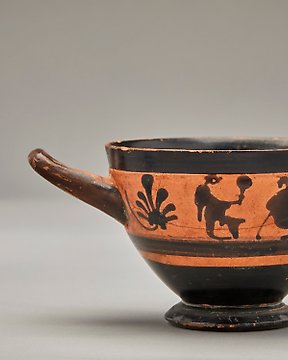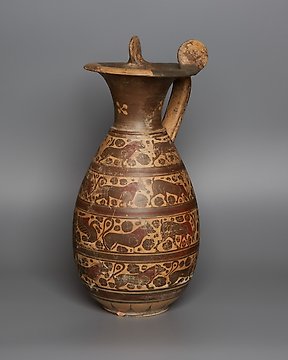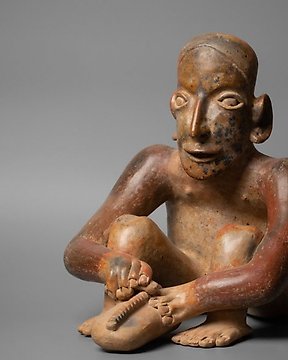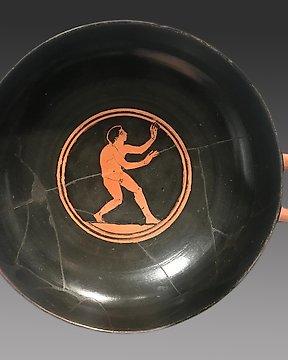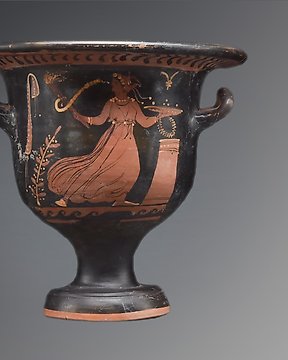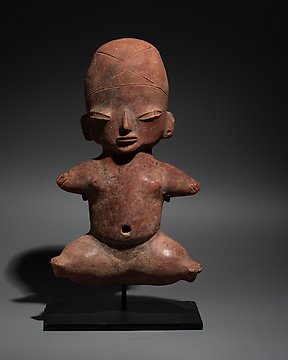BEL OBJET ANCIEN DE QUALITE BIEN EMBALLE ET ACHEMINE
Voir la traductionGrec antique mycénien Céramique Skyphos avec scènes de chars. 6ème siècle avant JC. 27,3 cm de longueur.
Nº 85665001



Skyphos with chariot scenes.
Ancient Greek, Attica, 6th century BC.
Ceramic.
27.3 cm Large and 11.5 cm heigth.
Condition: Recomposed from all original fragments.
Provenance: Private collection, Mr. S, Ghent, Belgium. 1970 - 1980.
Description:
A skyphos is a deep wine cup with two handles and a low, wide base, or no base. The handles are small and horizontal, projecting from the edge, or loop-shaped that sit on the edge or protrude from the base. There is a type of this glass called glaux (owl) that has one horizontal handle and the other vertical. The oldest examples are from the Geometric period. They were also made with precious metals.
The black figure technique was based on the use of a transparent varnish that, when fired, acquired an intense and shiny black hue. Therefore, the motifs were invisible before firing, due to which the painters had to work completely from memory, without being able to see their previous work. Once the piece was fired, the areas not covered by the varnish remained with the reddish tone of the clay, while the glazed, “painted” areas took on a dense and shiny black color. The black figure technique was introduced in Corinth around 700 BC, being adopted by Attic artists in the orientalizing period (725 – 625 BC). The great series of black-figure ceramics then began, which had its main center in Athens and which lasted until the beginning of the 5th century BC.
Attica, a region in southern Greece that has Athens as its capital, was therefore the birthplace of the red figure technique at the end of the 6th century. It remained the main center of production for this type of pottery, although the style was also adopted in other parts of Greece, Magna Graecia (Italy) and Etruria. The previous style, that of black figures, had appeared in Corinth in the 7th century BC. At first, Athens copied the Corinthian style, but it soon achieved such quality that it rivaled, first, and then surpassed Corinth itself. Attic artists, still in the black-figure period, brought the style to the peak of its development in the mid-6th century BC. By the following century, Attica completely dominated the market, with predominantly red-figure ceramics that were exported throughout Greece and even to Italy, where its own schools were developed, strongly influenced by the Attic style.
Notes:
- The piece includes authenticity certificate.
- The piece includes Spanish Export License (Passport for European Union) - If the piece is destined outside the European Union a substitution of the export permit should be requested, can take between 1-2 weeks maximum.
- The seller guarantees that he acquired this piece according to all national and international laws related to the ownership of cultural property. Provenance statement seen by Catawiki.
#ancientcivilisations
À propos du vendeur
Skyphos with chariot scenes.
Ancient Greek, Attica, 6th century BC.
Ceramic.
27.3 cm Large and 11.5 cm heigth.
Condition: Recomposed from all original fragments.
Provenance: Private collection, Mr. S, Ghent, Belgium. 1970 - 1980.
Description:
A skyphos is a deep wine cup with two handles and a low, wide base, or no base. The handles are small and horizontal, projecting from the edge, or loop-shaped that sit on the edge or protrude from the base. There is a type of this glass called glaux (owl) that has one horizontal handle and the other vertical. The oldest examples are from the Geometric period. They were also made with precious metals.
The black figure technique was based on the use of a transparent varnish that, when fired, acquired an intense and shiny black hue. Therefore, the motifs were invisible before firing, due to which the painters had to work completely from memory, without being able to see their previous work. Once the piece was fired, the areas not covered by the varnish remained with the reddish tone of the clay, while the glazed, “painted” areas took on a dense and shiny black color. The black figure technique was introduced in Corinth around 700 BC, being adopted by Attic artists in the orientalizing period (725 – 625 BC). The great series of black-figure ceramics then began, which had its main center in Athens and which lasted until the beginning of the 5th century BC.
Attica, a region in southern Greece that has Athens as its capital, was therefore the birthplace of the red figure technique at the end of the 6th century. It remained the main center of production for this type of pottery, although the style was also adopted in other parts of Greece, Magna Graecia (Italy) and Etruria. The previous style, that of black figures, had appeared in Corinth in the 7th century BC. At first, Athens copied the Corinthian style, but it soon achieved such quality that it rivaled, first, and then surpassed Corinth itself. Attic artists, still in the black-figure period, brought the style to the peak of its development in the mid-6th century BC. By the following century, Attica completely dominated the market, with predominantly red-figure ceramics that were exported throughout Greece and even to Italy, where its own schools were developed, strongly influenced by the Attic style.
Notes:
- The piece includes authenticity certificate.
- The piece includes Spanish Export License (Passport for European Union) - If the piece is destined outside the European Union a substitution of the export permit should be requested, can take between 1-2 weeks maximum.
- The seller guarantees that he acquired this piece according to all national and international laws related to the ownership of cultural property. Provenance statement seen by Catawiki.
#ancientcivilisations
À propos du vendeur
- 746
- 7
- 0
Todo correcto. Gracias
Voir la traductionTrès beaux objets!!! Livraison rapide et soignée. Meeci👏🏻
Voir la traductionTop vendeur
Voir la traductionEl objeto tenia algunos problemas que fueron solucionados por la empresa, labor excelente y pocas veces vista en este tipo de transacciones. Mis felicitaciones a la empresa
Voir la traductionFast delivery, object fine. However, bad carrier: please never use again DHL express as they are "DHL slow": instead of coming to my address, they put it directly to a DHL Service Point/Locker.
Voir la traductionTodo correcto
Voir la traductionI am very happy with the ancient bronze horse. Excellent that it was delivered within a few days. My compliments to J.Bagot Arqueologia- Ancient Art, well done! Ron van Schaick
Voir la traductionPerfect transaction and fantastic item. Thank you.
Voir la traductionconforme rapide hope other thanks ++++
Voir la traductionKülönleges eszköz, jó állapotban van, köszönöm a rendkívül gyors szállítást. Ajánlom az Eladót!
Voir la traductionfast delivery, good packaging
Voir la traductionGood seller: fast shipment, good packing and a very nice object. Thank you!
Voir la traductionsuper 💯💯💯💯💯
Voir la traductionIl pezzo è arrivato in condizioni perfette il pacco era protetto alla perfezione
Voir la traductionBuenos días, señor. ¡Gracias por las precauciones de embalaje Tip / Top! Muy contento con mi compra. ¡Gracias!
Voir la traductionPerfecto! :)
Voir la traductionWunderbares Stück. Alles wie beschrieben. Hervorragender Kontakt.
Voir la traductionExtremely rapid courrier service from Barcelona to Flanders, picture was nicely and carefully packaged. Muchas gracias!
Voir la traductionVery fine specimen! Thanks.
Voir la traductiongoede foto's, goede omschrijving, goed verpakt en snel verzonden.
Voir la traductionmolto bello tutto ok
Voir la traductionPezzo come da descrizione, davvero notevole. Venditore molto consigliato in quanto gentile e disponibile. spedizione molto veloce. Ottimo!
Voir la traductionVenditore davvero ottimo e gentile. Merce come da descrizione, spedizione veloce. Ottimo l'avere certificato di autenticità.
Voir la traduction- 746
- 7
- 0
BEL OBJET ANCIEN DE QUALITE BIEN EMBALLE ET ACHEMINE
Voir la traductionMentions légales
Le vendeur garantit que l'objet a été obtenu légalement et est en mesure de le prouver. Le vendeur a été informé par Catawiki qu'il devait fournir les documents requis par les dispositions législatives et réglementaires de son pays de résidence. Le vendeur garantit qu’il est autorisé à vendre/exporter cet objet. Le vendeur fournira à l'acheteur toutes les informations connues sur la provenance de l'objet. Le vendeur veillera à ce que tous les permis nécessaires soient (déjà) obtenus. Le vendeur informera immédiatement l'acheteur en cas de retard dans l'obtention de ces permis.
Le vendeur garantit que l'objet a été obtenu légalement et est en mesure de le prouver. Le vendeur a été informé par Catawiki qu'il devait fournir les documents requis par les dispositions législatives et réglementaires de son pays de résidence. Le vendeur garantit qu’il est autorisé à vendre/exporter cet objet. Le vendeur fournira à l'acheteur toutes les informations connues sur la provenance de l'objet. Le vendeur veillera à ce que tous les permis nécessaires soient (déjà) obtenus. Le vendeur informera immédiatement l'acheteur en cas de retard dans l'obtention de ces permis.
